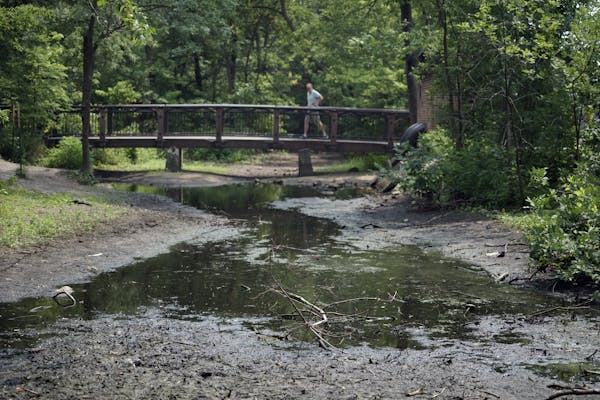Drought-ravaged dairy farms are closing and produce farmers can't grow enough to maintain sales, Minnesota farmers told state leaders as they called for quick help.
Federal aid should soon be on the way. Gov. Tim Walz announced at a news conference with farmers Friday that Minnesota will get roughly $17 million from the federal government for disaster mitigation. He is still figuring out exactly how the state will use the money, but he said he wants to get assistance to farmers as fast as possible.
State government also needs to act to ensure more farmers make it through the unusually dry, hot summer, Walz said. The governor said he is talking with legislators about passing a farm aid package when lawmakers gather in September for a special session. That could include emergency grants and some tax relief, he said.
"This is not about a brown yard for folks. This is about an economic disaster, in many cases, that needs to be addressed," Walz said.
Dry years are likely to become more common with climate change, Walz added, and suggested the University of Minnesota should put more resources toward researching drought-resistant crops.
Dairy farms have been particularly hard-hit as they struggle to obtain the feed needed for their livestock operations.
Minnesota lost 21 dairy farms last month, Department of Agriculture Commissioner Thom Petersen said.
"That's a really hard number, and I'm afraid we're going to lose more," he said.
The dry conditions have limited hay production, and prices have skyrocketed.
"You choose to either stay in business and try to buy hay that you can't afford, or go out of business," said Rachel Gray, who has a cattle ranch in the northern city of Blackduck.
While she was on the Zoom call Friday with the governor, commissioner and other farmers, Gray said semitrailer trucks were at her farm to pick up her cattle and take them to feedlots in southern Minnesota and Missouri. Gray said she is lucky not to be going out of business. But she is transitioning how she operates. Gray said she will not bring her cattle back to Blackduck and instead will be developing heifers at feedlots in other states.
As farms close down or shift livestock elsewhere, rural communities suffer because farmers will no longer buy supplies and food locally, Gray said.
It's not just livestock farmers who are struggling.
Some farmers who bring their produce to the Mill City Farmers Market have had their wells run dry or have been forced to pump water out of creeks, which can be a food safety issue, said Kathy Zeman, director of the Minnesota Farmers' Market Association. She said farmers who would typically work 10 hours a day this time of year are now clocking in at 16 hours as they try to ensure they have enough water.
On top of that, the swing from cold to hot temperatures has increased pest problems, said Janssen Hang, executive director of the Hmong American Farmers Association. Some farmers who usually sell their crops six days a week are now only going to the market to sell two days a week, Hang said.
"We are here to provide increased food access to our community members," Hang said. "But because of the lack of rain and the drought and the impact of the heat, farmers are not able to provide that necessary resource to our community members."
Former DFL Senate Majority Leader Kari Dziedzic dies of cancer at age 62

How the Star Tribune is covering the 2024 election

Fact check: Walz and Vance made questionable claims during only VP debate

In Tim Walz's home city, opposing groups watch him debate on the national stage

